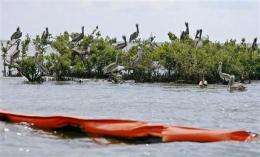Mangrove Island, a delicate breading ground for Louisiana's brown pelicans located in Barataria Bay near Grand Isle, La., is covered with birds and surrounded by boom Wednesday, Aug. 18. 2010. Some of the boom has washed ashore and oil effected birds are being rescued everyday, though the numbers are decreasing rapidly. (AP Photo/Kerry Maloney)
(AP) -- The U.S. government said Thursday the final plugging of BP's blown-out Gulf well will begin sometime after Labor Day.
Jeffrey Carter, an aide to the government's spill chief, told The Associated Press that the plan is to replace a failed piece of equipment called the blowout preventer first.
Then BP will finish drilling a relief well it can use to plug up the blown-out well with mud and cement from the bottom, a procedure known as a bottom kill.
Carter said that if everything goes as planned, the final plugging will begin after Sept. 6.
"That's the anticipation, yes," Carter said. "So long as the conditions are met."
He said the decision on the path forward was made overnight, just hours after retired Coast Guard Adm. Thad Allen told reporters he wasn't giving a timeline.
Carter said he did not know why things came together so quickly or why it will take nearly three more weeks to begin the bottom kill.
Allen had said replacing the blowout preventer was the quicker of the two options engineers were considering to relieve pressure that may build up when the relief well intersects the blown-out well. The other was to design a mechanism to attach to the current equipment.
BP's well blew out when the offshore drilling rig Deepwater Horizon exploded April 20, killing 11 workers and setting off one of the worst offshore oil spills in history.
A cap has kept oil from flowing for more than a month, but that's just a temporary solution. Mud and cement was later pumped in through the top of the well, significantly reducing the pressure inside it.
But the government believes the bottom kill procedure is necessary to declare the well dead once and for all.
©2010 The Associated Press. All rights reserved. This material may not be published, broadcast, rewritten or redistributed.























